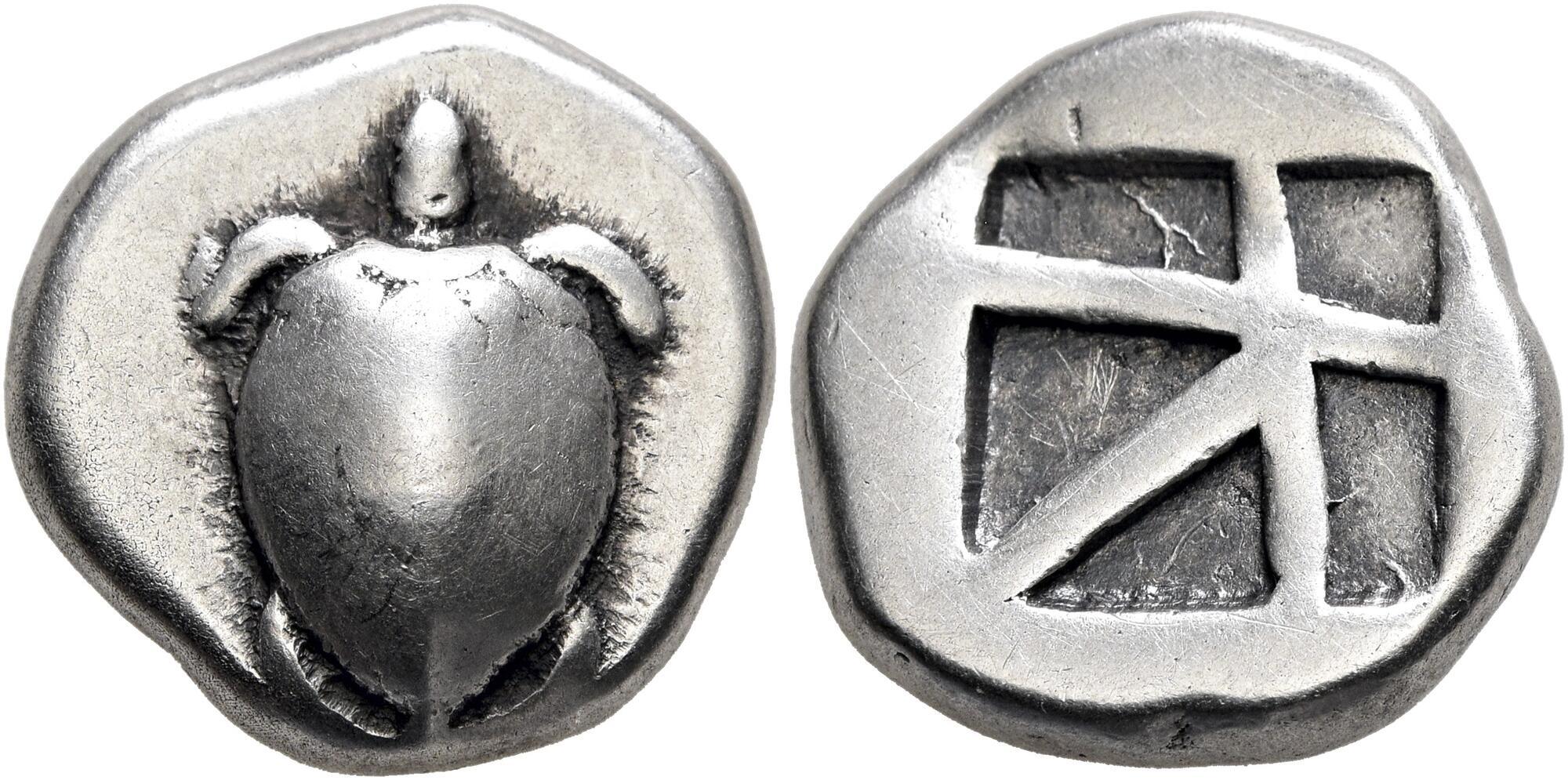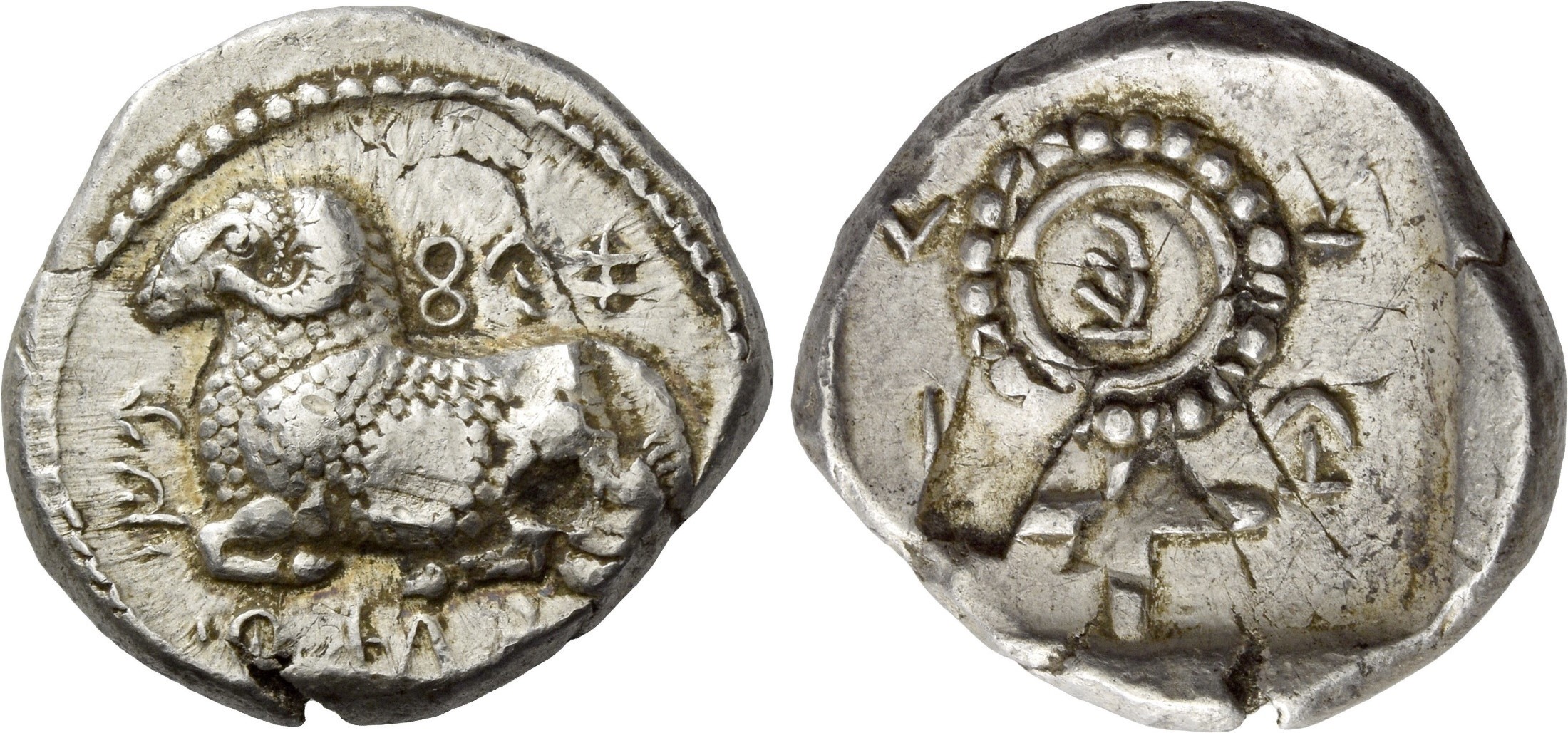1800 - Salamis (Nikodamos) (double siglos ram/ankh) over Aegina (tortoise/incuse square) (NAC, 106, 9 May 2018, 310)
From SILVER
m (Callatay moved page SO 1138 - Salamis over Aegina to 1800 - Salamis over Aegina (Gorny, 69, 1994, 424)) |
|||
| (4 intermediate revisions by the same user not shown) | |||
| Line 1: | Line 1: | ||
{{Overstrike | {{Overstrike | ||
| − | |Sale= | + | |Image overstriking coin=Salamis_1800_NAC.jpg |
| − | |Archaeological context=Hoard from East (Pfisterer A24) | + | |Image overstruck variety=Aegina 5 parts.jpg |
| + | |Image reference overstruck variety=https://pro.coinarchives.com/a/lotviewer.php?LotID=2238447&AucID=5442&Lot=855 | ||
| + | |Sale=Numismatica Ars Classica, 106, 9 May 2018, 310 = Giessener Münzhandlung Dieter Gorny, 69, 1994, 424 | ||
| + | |Archaeological context=Hoard from East (Pfisterer A24) | ||
|Obverse legend="pa-si-le-wo-se/ni-ko" (Cypriot syllabic) | |Obverse legend="pa-si-le-wo-se/ni-ko" (Cypriot syllabic) | ||
| + | |Obverse legend language=Cypriot | ||
|Obverse description=Ram lying left. | |Obverse description=Ram lying left. | ||
|Reverse legend="pa / ni-ko-ta-mo" (Cypriot syllabic) | |Reverse legend="pa / ni-ko-ta-mo" (Cypriot syllabic) | ||
| + | |Reverse legend language=Cypriot | ||
|Reverse description=Ankh within incuse square. | |Reverse description=Ankh within incuse square. | ||
|Mint=Salamis | |Mint=Salamis | ||
|Ancient region=Cyprus | |Ancient region=Cyprus | ||
|Authority=Nikodamos of Salamis (king of Salamis, third quarter of the 5th century BC) | |Authority=Nikodamos of Salamis (king of Salamis, third quarter of the 5th century BC) | ||
| + | |Date from=460 BCE | ||
| + | |Date to=450 BCE | ||
| + | |Period=Classical | ||
| + | |Metal=Silver | ||
|Weight=11.32 | |Weight=11.32 | ||
| − | |Denomination=siglos | + | |Denomination=double siglos |
| − | |Coin reference= | + | |Standard=Persian |
| − | |Overstruck obverse description= | + | |Coin reference=Destrooper-Georgiades 2013, p. 21, n° 24 |
| − | |Overstruck reverse description= | + | |Coin series reference=Zapiti - Michaelidou 2008, n° 12; Destrooper-Georgiades 2013, p. 21, n° 24 |
| + | |Coin series web reference=https://greekcoinage.org/iris/id/salamis_cyprus.nikodamos.bmc.31 | ||
| + | |Overstruck obverse description=Land tortoise with segmented shell (visible on the coin's obverse). | ||
| + | |Overstruck reverse description=Large square incuse with heavy skew pattern (visible on the coin's reverse : mill-sail reverse pattern). | ||
|Overstruck mint=Aegina | |Overstruck mint=Aegina | ||
| − | |Overstruck ancient region= | + | |Overstruck ancient region=Attica |
| + | |Overstruck date from=460 BCE | ||
| + | |Overstruck date to=430 BCE | ||
| + | |Overstruck period=Classical | ||
| + | |Overstruck denomination=stater | ||
| + | |Overstruck standard=Aeginetic | ||
| + | |Coin series reference overstruck=HGC 6, n° 435 ; Meadows (forthcoming), Groups IIa-IIb | ||
| + | |Coin series web reference overstruck=https://greekcoinage.org/iris/id/aegina.meadows_askari.2a-c | ||
| + | |Frequency of overstrikes=exceptional | ||
| + | |Level of confidence=sure | ||
| + | |Remarks="Traces of overstriking" | ||
}} | }} | ||
Latest revision as of 08:31, 9 November 2023
460 BCE - 450 BCE"pa-si-le-wo-se/ni-ko" (Cypriot syllabic) | "pa / ni-ko-ta-mo" (Cypriot syllabic)
Images
Overstruck variety

Aegina 5 parts.jpg [1]
Location/history
| Sale(s)Sale(s) ᵖ: | Numismatica Ars Classica, 106, 9 May 2018, 310 = Giessener Münzhandlung Dieter Gorny, 69, 1994, 424 | |
| Archaeological contextArchaeological context: | Hoard from East (Pfisterer A24) |
Overstriking coin
Description
| ObverseInscription or printing placed on the obverse.: | "pa-si-le-wo-se/ni-ko" (Cypriot syllabic) (Cypriot) Ram lying left. | ReverseInscription or printing placed on the reverse.: | "pa / ni-ko-ta-mo" (Cypriot syllabic) (Cypriot) Ankh within incuse square. |
Mint and issuing power
| MintIdentifies the place of manufacture or issue of a numismatic object.: | Salamis | Ancient regionAncient region. | Cyprus | Modern countryModern country: Turkey | AuthorityIdentifies the issuing power. The authority can be "pretended" when the name or the portrait of X is on the coin but he/she was not the issuing power. It can also be "uncertain" when there is no mention of X on the coin but he/she was the issuing power according to the historical sources: | Nikodamos of Salamis (king of Salamis, third quarter of the 5th century BC) |
Chronology
| FromIdentifies the initial date in a range assigned in a numismatic context. 460 BCE toIdentifies the final date in a range assigned in a numismatic context.. 450 BCE | Classical 480-323 BC |
Physical description
| MetalThe physical material (usually metal) from which an object is made.: Silver |
WeightWeight of the numismatic object (in grams). in grams: 11.3211.32 g <br />11,320 mg <br /> | DenominationTerm indicating the value of a numismatic object. Examples: tetradrachm, chalkous, denarius.: double siglos |
|
| StandardStandard.: Persian | |||
References
| Coin referenceReference of the Coin: | Destrooper-Georgiades 2013, p. 21, n° 24 | Coin series referenceReference to coin series study: | Zapiti - Michaelidou 20081Zapiti - Michaelidou 2008, n° 12, Destrooper-Georgiades 20132Destrooper-Georgiades 2013, p. 21, n° 24 |
| Coin series web referenceCoin series web references: | |||
Overstruck type
Description
| ObverseInscription or printing placed on the obverse.: | Land tortoise with segmented shell (visible on the coin's obverse). | ReverseInscription or printing placed on the reverse.: | Large square incuse with heavy skew pattern (visible on the coin's reverse : mill-sail reverse pattern). |
Mint and issuing power
| MintIdentifies the place of manufacture or issue of a numismatic object. ᵖ: | Aegina | Ancient regionAncient region. ᵖ | Attica | Modern countryModern country: Greece | AuthorityIdentifies the authority in whose name (explicitly or implicitly) a numismatic object was issued. ᵖ: |
Chronology
| FromIdentifies the initial date in a range assigned in a numismatic context. 460 BCE toIdentifies the final date in a range assigned in a numismatic context.. 430 BCE | Classical 480-323 BC |
Physical description
| DenominationTerm indicating the value of a numismatic object. Examples: tetradrachm, chalkous, denarius. ᵖ: | stater |
StandardStandard. ᵖ: | Aeginetic |
References
| Coin type referenceReference to coin series study ᵖ: | HGC 63HGC 6, n° 435, Meadows (forthcoming)4Meadows (forthcoming), Groups IIa-IIb | ||
| Coin series web reference overstruckCoin series web references overstruck: | |||
Additional data
| Frequency of overstrikesFrequency of overstrikes: | exceptional | Level of confidenceLevel of confidence of the identification: | sure |
| RemarksRemarks: | "Traces of overstriking" | ||
References
- ^ Zapiti, Eleni - Michaelidou, Lefki (2008), Coins of Cyprus : from the collection of the Bank of Cyprus Cultural Foundation, Nicosia, Bank of Cyprus Cultural Foundation, 329 p.
- ^ Destrooper-Georgiades, A. (2013), "Monnaies chypriotes surfrappées des cités-royaumes," in Demetrios Michaelides (ed.), Epigraphy, numismatics, prosopography and History of Ancient Cyprus. Papers in honour of Ino Nicolaou, Studies in Mediterranean Archaeology and Literature PB 179, Uppsala, p. 9-40.
- ^ Hoover, Oliver D. (2010), The Handbook of Greek Coinage Series, volume 6 : handbook of coins of the islands: Adriatic, Iionian, Thracian, Aegean, and Carpathian seas (excluding Crete and Cyprus), sixth to first centuries BC, Lancaster, 358 p.
- ^ Meadows, Andrew (forthcoming), Greek coinage in the Persian Empire: The Malayer 1934 Hoard (IGCH 1790).
